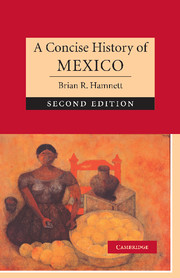Book contents
- Frontmatter
- Contents
- List of illustrations
- Chronology
- Preface to the second edition
- Preface to the first edition
- 1 Mexico in perspective
- 2 The pre-Columbian era
- 3 The European incursion, 1519–1620
- 4 New Spain, 1620–1770: Spanish colonialism and American society
- 5 Destabilisation and fragmentation, 1770–1867
- 6 Reconstruction, 1867–1940
- 7 The monopoly party, 1940–2000
- 8 The Fox administration, 2000–2006
- 9 Cultural developments since Independence
- Final comments
- Bibliography
- Index
- Titles in the series
Preface to the first edition
Published online by Cambridge University Press: 05 June 2014
- Frontmatter
- Contents
- List of illustrations
- Chronology
- Preface to the second edition
- Preface to the first edition
- 1 Mexico in perspective
- 2 The pre-Columbian era
- 3 The European incursion, 1519–1620
- 4 New Spain, 1620–1770: Spanish colonialism and American society
- 5 Destabilisation and fragmentation, 1770–1867
- 6 Reconstruction, 1867–1940
- 7 The monopoly party, 1940–2000
- 8 The Fox administration, 2000–2006
- 9 Cultural developments since Independence
- Final comments
- Bibliography
- Index
- Titles in the series
Summary
Research on Mexico is an exciting and fast-developing topic. Perspectives are repeatedly changing. Mexico, with a population around 95 million, forms part of the North American sub-continent. Since the early sixteenth century, it has been part of the Atlantic world that resulted from European expansion. Before that time, Mexico was also part of a pre-Columbian world unknown to Europeans. For that reason, the country has a complex multi-ethnic and multi-cultural pattern that continues to have an impact on contemporary events. Nevertheless, anyone interested in Mexico quickly discovers that there are few things for the beginner to read. At the same time, those who perhaps might have returned from their first visit to the country will frequently look in vain for a book which enables them to analyse what they have seen with any thematic coherence.
I first went to Mexico as a research student in January 1966. A great deal of my own history has been lived there since that time, and the country itself has in some respects changed beyond recognition. Yet, at the same time, particularly in the provinces and the villages, and in general attitudes and assumptions, a great deal of the traditional outlook, for better or for worse, still persists.
Approaching Mexican history as I initially did from the geographical perspectives of the centre and south, the core zones of Mesoamerican civilisation, I was always conscious of the deeply rooted inheritance of the indigenous American past.
- Type
- Chapter
- Information
- A Concise History of Mexico , pp. xx - xxivPublisher: Cambridge University PressPrint publication year: 2006

